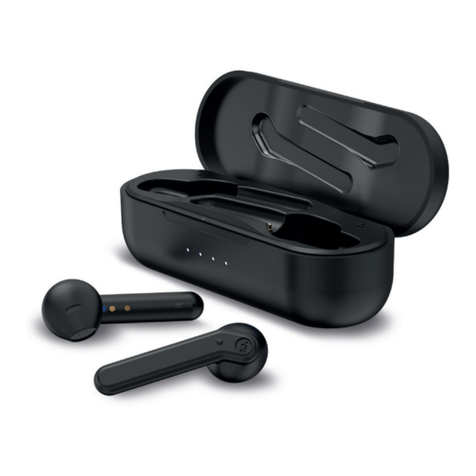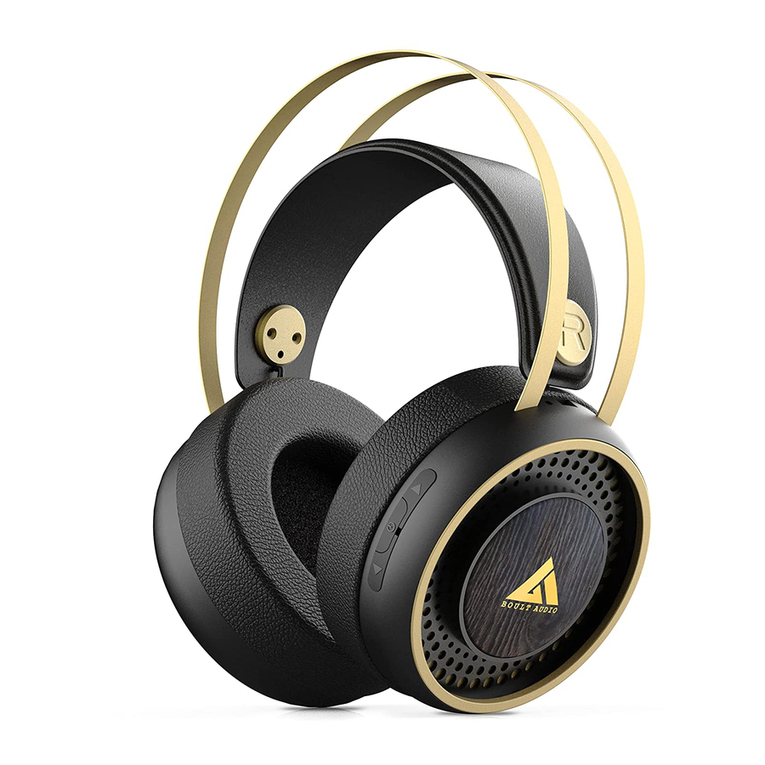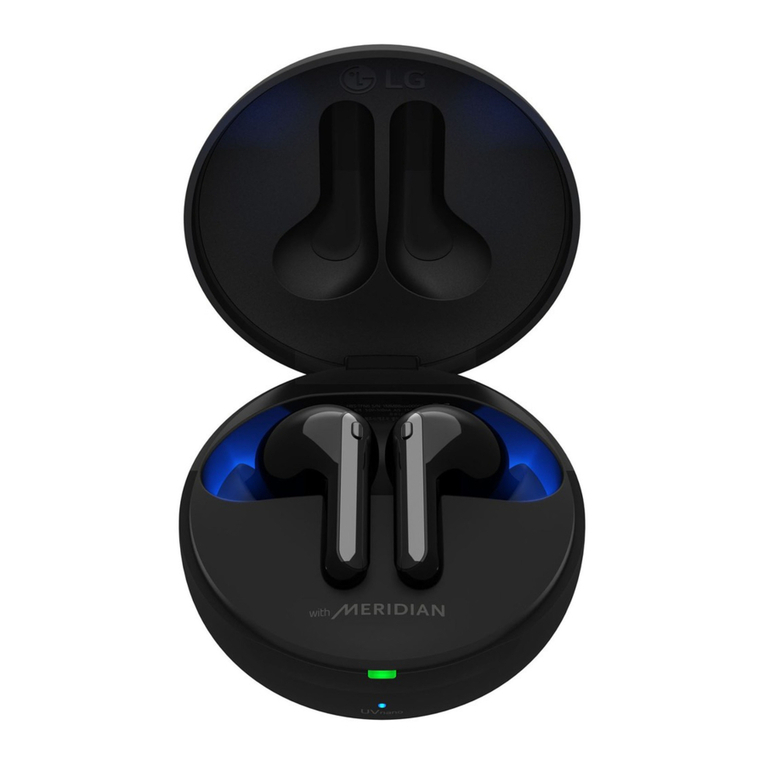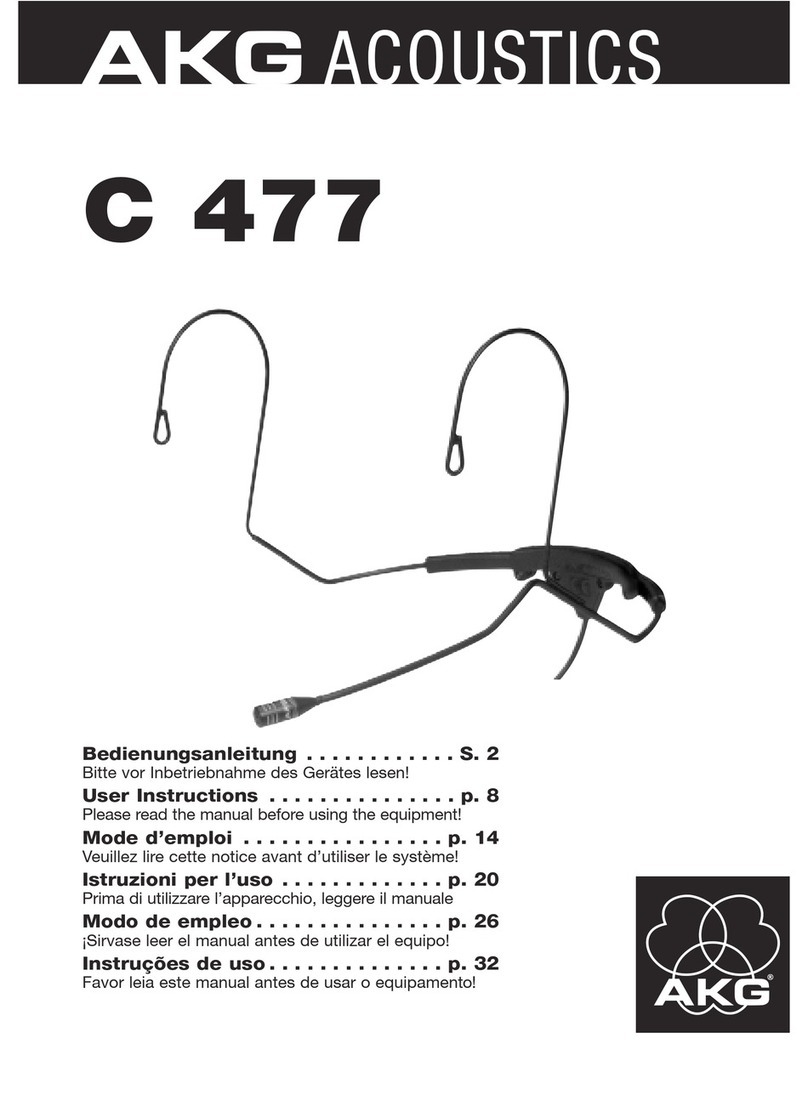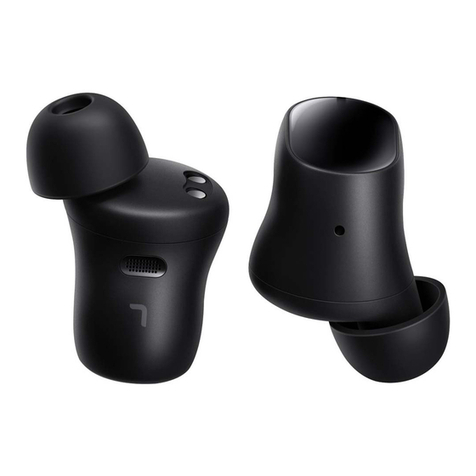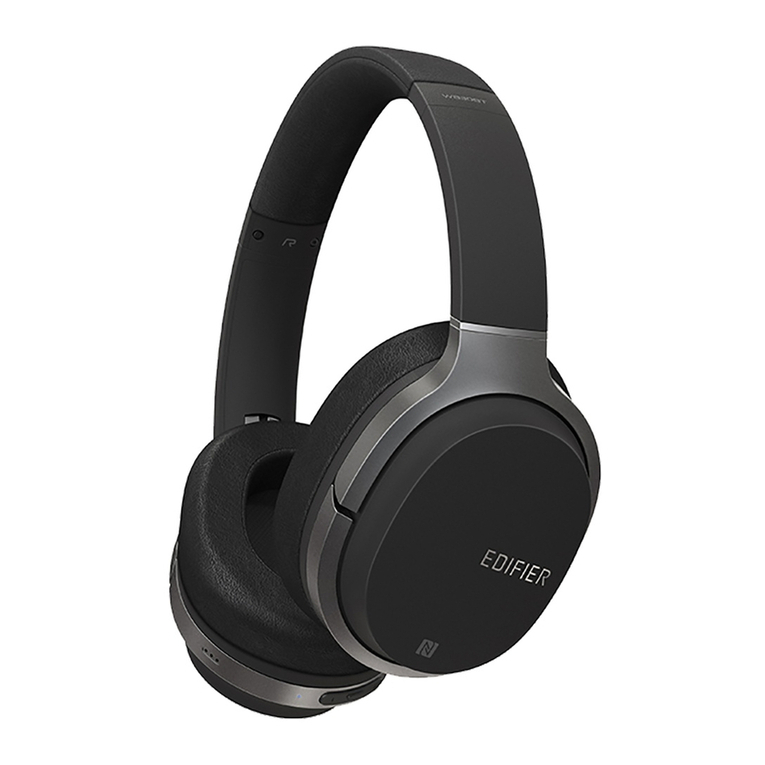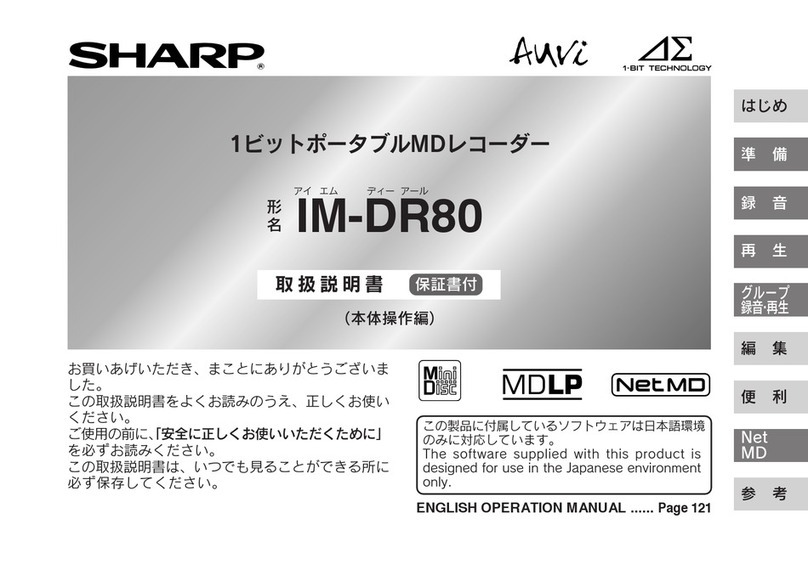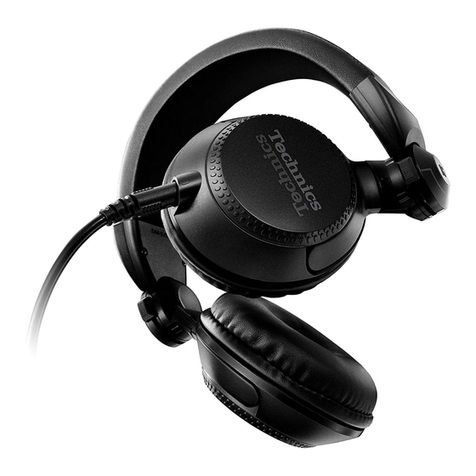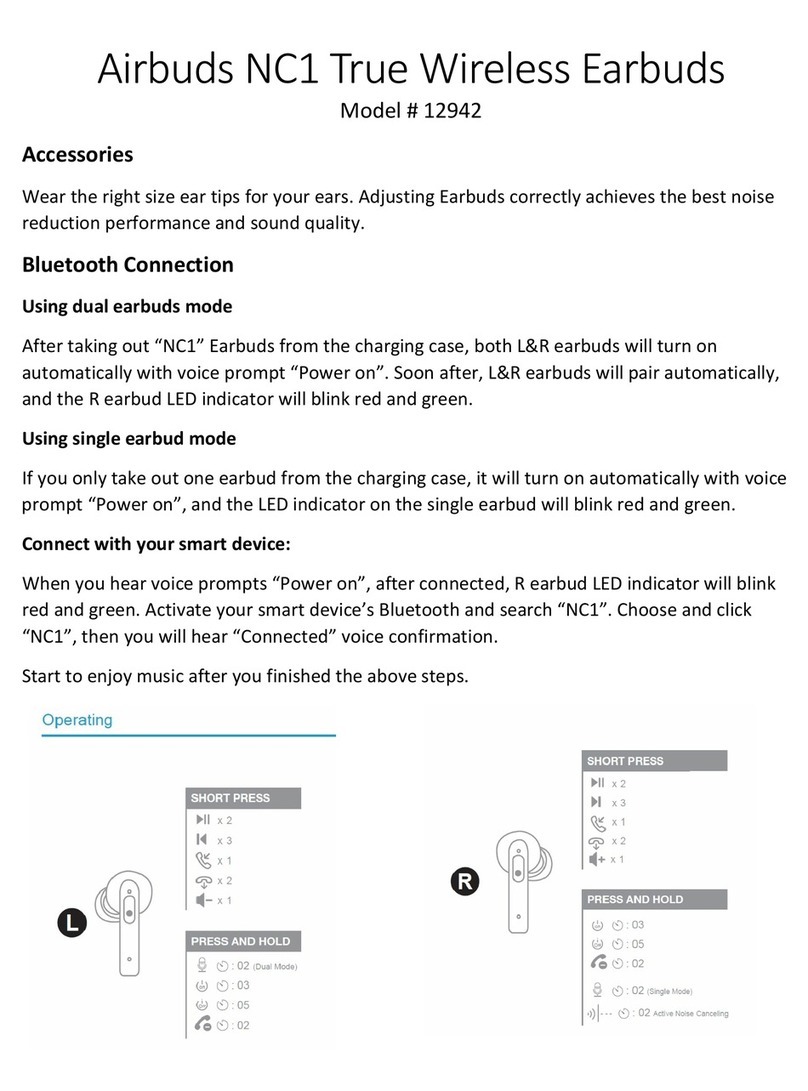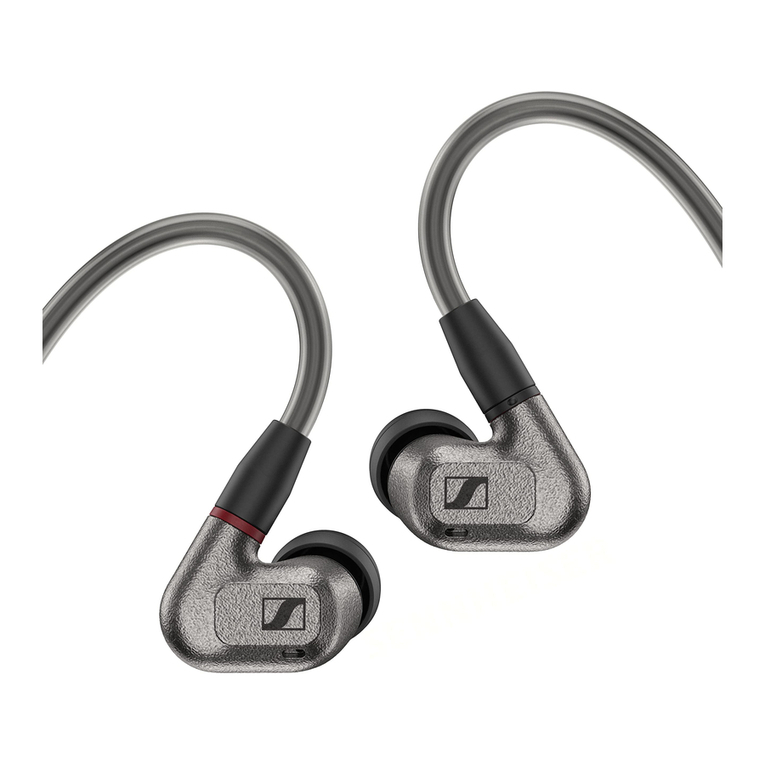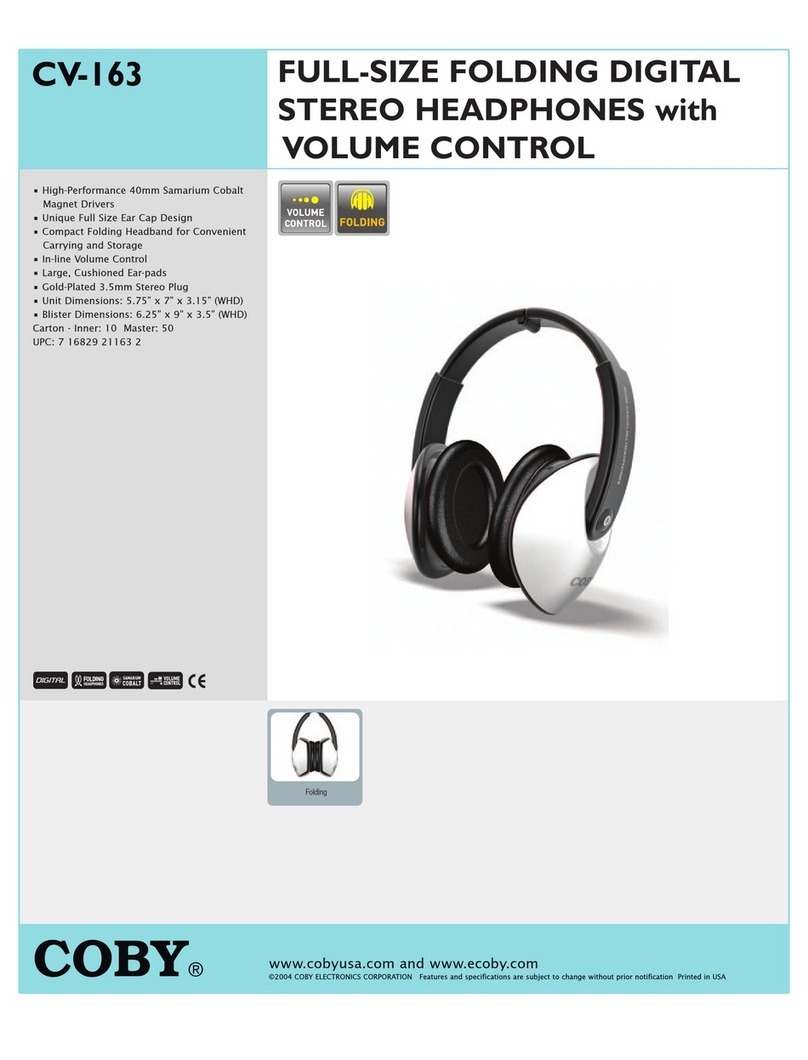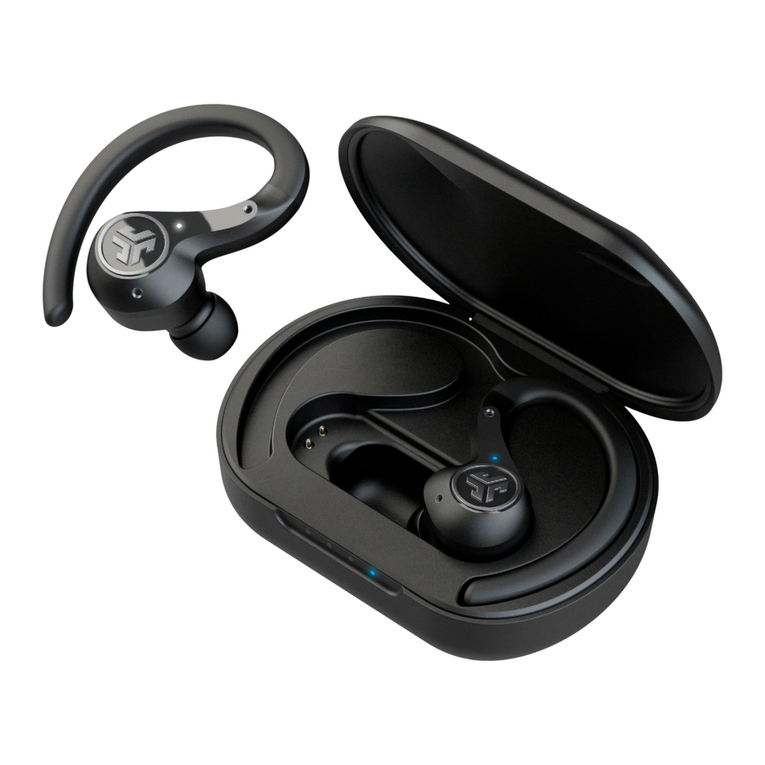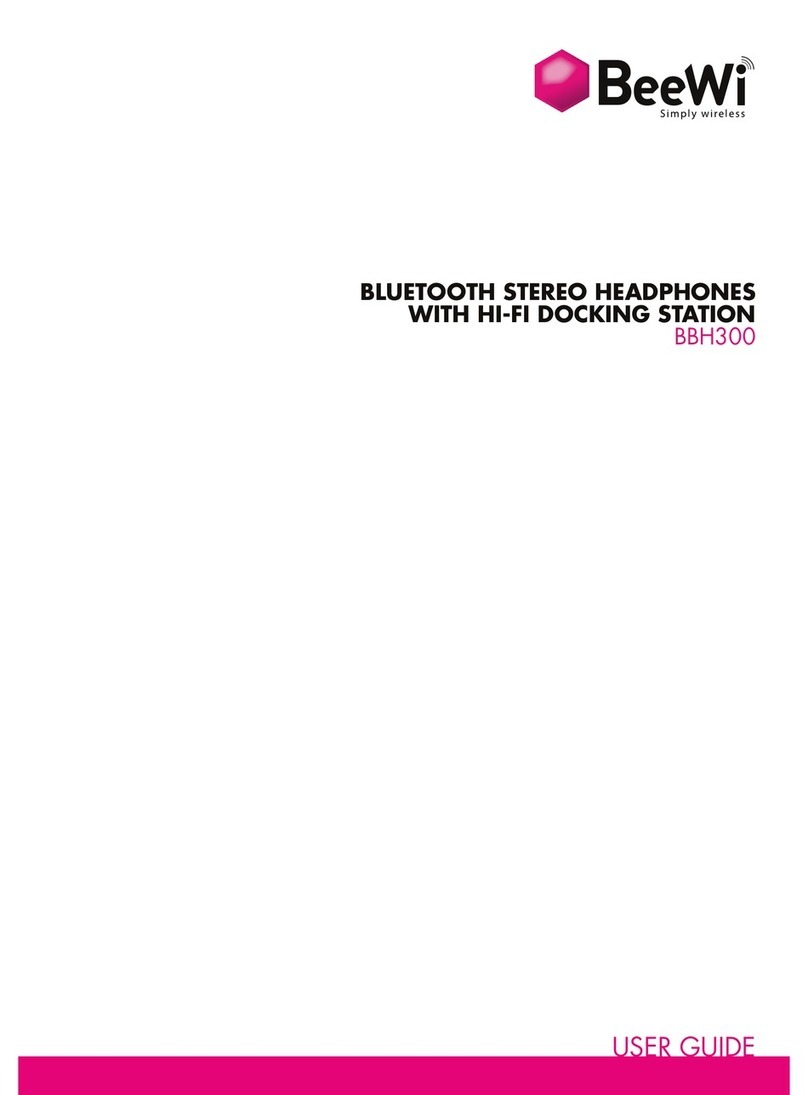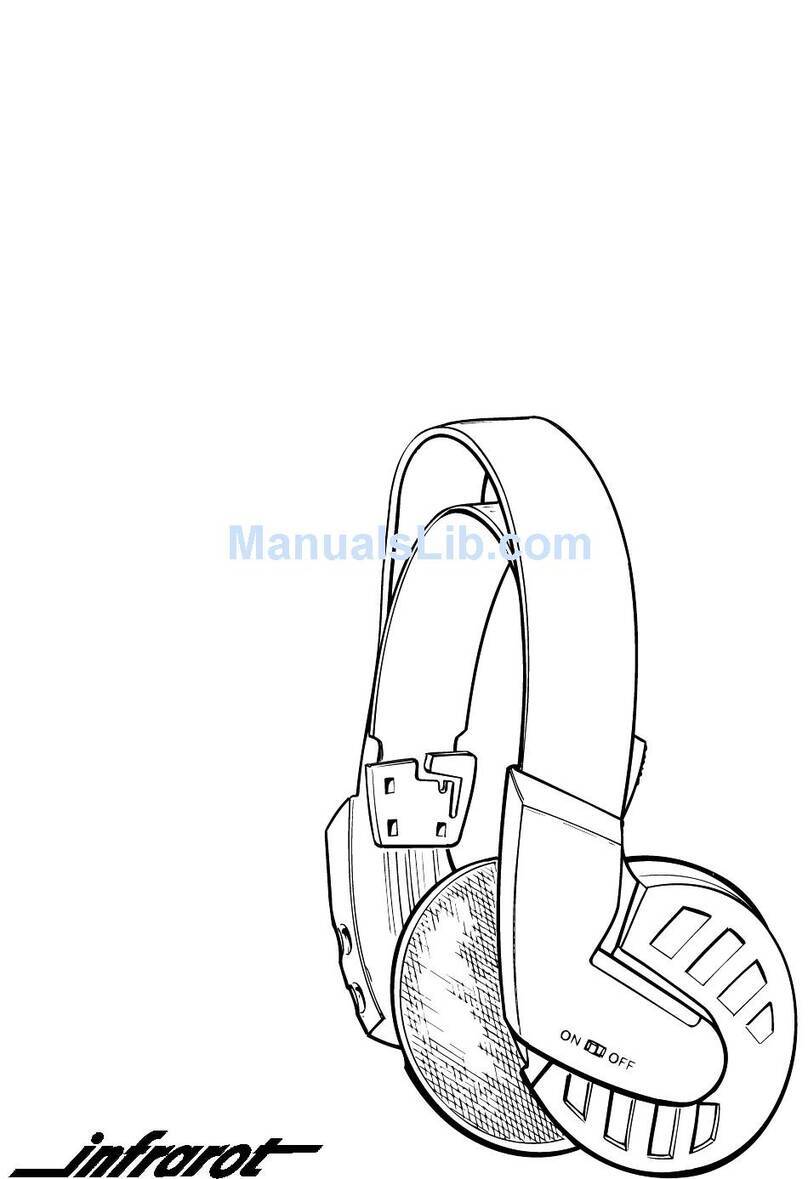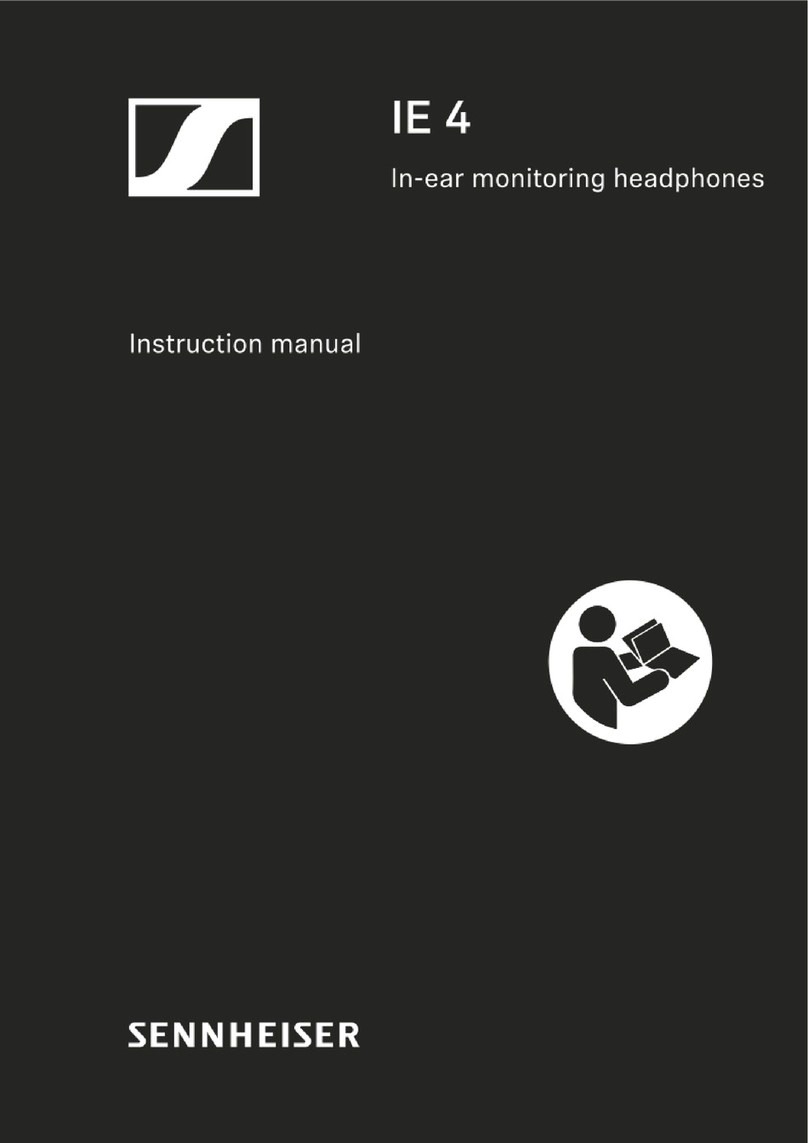Aearo E-A-RTONE 3A User manual

Instructions for the use of
E-A-RTONE®3A
Insert Earphones
Revised 1997 per ANSI S3.6-1996 and ISO 389-2:1994
12/99

1
INTRODUCTION
Congratulations on the purchase of your new E-A-RTONE®3A Insert Earphones. Whether you are performing hearing screening in
an educational or industrial setting, testing related to the fitting or evaluation of amplification, audiological research, or
comprehensive diagnostic assessment, E-A-RTONE®3A Insert Earphones provide many advantages that can enhance test reliability
and minimize or eliminate problems frequently encountered with supra-aural headphones.
Because the subject’s external canal is sealed with an E-A-RLINK®foam plug, which functions as a sound delivery system while at
the same time attenuating ambient noise, reliable threshold measurement can be accomplished in environments previously unsuitable
for hearing testing.
Direct coupling also produces much greater sound separation between ears across the test frequency range. Clinically, that means
more instances where the need for masking is eliminated, or the level necessary for effective masking is lower. Your average testing
time will decrease without sacrificing reliability. The method of clinical masking you use does not need to be altered. Simply
substitute the greater inter-aural attenuation values cited in the Obtained Interaural Attenuation table in section 1. of this booklet.
E-A-RLINK®foam plugs are available from your distributor in three sizes; a standard (3A) plug that will comfortably fit most adult
ear canals, a pediatric (3B) size for small canals, and an extra large (3C) size for very large or surgically altered ear canals.
Disposable plugs also insure that sanitary conditions exist for each of your patients, and that periodic cleaning of a headband or
cushion is no longer required.
The E-A-RTONE®3A Insert Earphone is offered with three levels (10V, 50V, & 300V) of impedance to match the output of most
commercially available audiometers. Your distributor or Auditory Systems can help you determine which version is appropriate for
your equipment.
E-A-RTONE®3A Insert Earphones were designed to mimic the frequency response of the TDH type earphone. It is strongly
recommended, however, that the (RETSPL) values and procedure cited in the ANSI S3.6 -1996 Standard be used in recalibration,
before initial use, unless your audiometer was purchased with an E-A-RTONE®3A as the standard transducer, and at least annually
thereafter. Measured correction factors can be applied in those cases where it is necessary to alternate between an insert earphone
and a supra-aural earphone.
This instruction booklet is intended to provide information to allow you to perform hearing testing with your audiometer and E-A-
RTONE®3A Insert Earphones with the confidence that results will be comparable to, or in certain instances more reliable than,
measurements performed with supra-aural headphones. Most questions regarding use and calibration of E-A-RTONE®3A Insert
Earphones can be answered by reviewing this booklet and/or ANSI S3.6-1996. For information regarding replacement items, please
contact your distributor or Auditory Systems Customer Service at 800/624-5955. Requests for technical assistance, or comments
regarding E-A-RTONE®3A Insert Earphones and E-A-RLINKS®should be directed to Aearo Company Auditory Systems at
317/692-6550.

2
1. Preliminary Procedures for Use of the E-A-RTONE®3A
Initially examine the ear canal for obstruction(s) and evaluate the proper size E-A-RLINK®disposable foam eartip needed to fit the
particular ear canal. Although the standard E-A-RLINK®3A fits most ear canals, for smaller ear canals, the smaller diameter
E-A-RLINK®3B eartips are available. It is important to obtain a good seal and achieve the proper insertion depth. Insertion
procedures are the same for the E-A-RLINK®3A and E-A-RLINK®3B, but deep insertion may be difficult to achieve in extremely
small ear canals. In these instances, a shallow placement will have to suffice.
Secure the section of black tubing, which protrudes from the
E-A-RLINK®eartips to the sound tube nipple located at the end of the E-A-RTONE®sound tube.
Slowly roll the E-A-RLINK®tip into the smallest diameter possible and insert the E-A-RLINK®well into the ear canal (see
illustrations).
Since the eartips are 12 mm long, the correct insertion depth into the ear canal is obtained when the rear edge of the E-A-
RLINK®is
2-3mm inside the entrance of the ear canal.
Hold E-A-RLINK®in ear canal until expanded.
After the test is completed, remove the E-A-RLINK®eartips and replace with a new pair for the next subject.
E-A-RLINK®
Full Insertion Shallow Insertion
Proper insertion depth is necessary to achieve maximum ambient noise attenuation and interaural attenuation. The graph below
depicts interaural attenuation as a function of insertion depth. The described interaural attenuation is obtained for each ear in which
the E-A-RLINK®is fully inserted, regardless of whether it is the “sending” ear or “receiving” ear.

3
-10
0
10
20
30
40
50
60
70
80
90
100
110
125 250 500 1000 2000 4000 8000 Hz
dB
Full E-A-RLINK insertion in both ears
Shallow insertion in dead ear only
Shallow insertion in both ears
Obtained Interaural Attenuation
2. Background Noise Reduction
A major benefit of the E-A-RTONE®Insert Earphone in combination with the E-A-RLINK®disposable foam eartips is the reduction
of background noise that might interact with the presented pure tones and influence the threshold determinations. When hearing
tests are performed outside a standard audiometric test booth and the E-A-RLINK®eartips are fitted to the subject according to the
instructions, the expected noise attenuation will typically exceed 30 dB in the frequency region 125-8000 Hz. This additional
attenuation will improve test precision in non-ideal environments and, in most cases, allow testing down to 0 dB HL in a background
noise level not exceeding 45 dB(A).
The latest ANSI Standard (ANSI S3.1-1999) “Maximum Permissible Ambient Noise Levels (MPANLs) For Audiometric Test
Rooms” Table 1 and Table 2 includes octave band and one-third octave band permissible noise levels for both supra-aural and Insert
Earphones. The ANSI octave band MPANLs are presented below for standard earphones and also for E-A-RTONES®with fully
inserted E-A-RLINKS®.
ANSI S3.1-1999 -Ears covered: octave band MPANLs using a supra-aural or insert earphone for three test frequency ranges re:
20?Pa to nearest 0.5 dB.
Supra-aural Earphone
E-A-RTONE Full Insertion
Octave
Band
Intervals
125 -
8,000 Hz
250 -
8,000 Hz
500 -
8,000 Hz
125 -
8,000 Hz
250 -
8,000 Hz
500 -
8,000 Hz
125 35.0 39.0 49.0 59.0 67.0 78.0
250 25.0 25.0 35.0 53.0 53.0 64.0
500 21.0 21.0 21.0 50.0 50.0 50.0
1000 26.0 26.0 26.0 47.0 47.0 47.0
2000 34.0 34.0 34.0 49.0 49.0 49.0
4000 37.0 37.0 37.0 50.0 50.0 50.0
8000 37.0 37.0 37.0 56.0 56.0 56.0
The ears covered MPANLs shown in the above table were derived using mean earphone attenuation values. To decrease the chance
that individual listeners for whom less than average attenuation is obtained will experience threshold shift, the MPANLs can be
lowered by reducing the amount of earphone attenuation. An appropriate reduction would be equal to the mean attenuation minus
one standard deviation. The net effect would be that the MPANLs would be lower (more stringent) for ears covered testing. This
reduction would cover about 84% of all subjects. The standard deviations for Insert Earphones for 125 to 8000 Hz are between three
(3) and six (6) decibels. Please refer to ANSI S3.1 –1999, Table A.2 for specific standard deviation values by frequency.

4
3. Positioning of the E-A-RTONE®
When positioning the E-A-RTONE®unit on the subject, avoid sound tube contact with the subject’s clothing. Always use E-A-
RLINK®tips in both ears, or block the opposite ear with an E-A-R®foam earplug.
4. Cord Assembly and Unit Placement
The cord assembly is zip-cord constructed. If more distance is needed between transducer cases carefully cut the insulation bridge
between the two cords and separate them to the desired distance. The proper location for the transducer cases is on either side of the
neck, not on the head. The metal clip equipped with a Velcro disk is intended to be used on the collar. A Velcro strap is also
supplied to make an optional neck loop. Attach one end to each of the cases. The resulting loop can be positioned behind the neck
with the cases resting on the shoulders and the cord in front hanging down the chest.
5. Blocked Tubing
If the clear sound tube is partially or fully blocked with fluid, wax, or other material, the sound output will be affected. To remedy
the problem, take the sound tube off at the case nipple and either blow air or push a thin wire through the tube. If the tubes turn
yellow or become damaged, replace them with new E-A-RTONE?specific parts. It is recommended that the sound tubes be replaced
annually.
6. Tubing Characteristics
The consequences of changing the length of the front tubes will be a change in the frequency response of the E-A-RTONE®unit.
The inner diameter, length and material used in the sound tubes have been carefully monitored by Auditory Systems to achieve
maximum accuracy, background noise attenuation and proper frequency response. If replacement sound tubes are needed, use only
Auditory Systems approved parts.
7. Pure Tone Calibration
When the E-A-RTONE®3A Insert Earphone is to be used as the primary transducer, the audiometer should be recalibrated using the
reference thresholds provided in the standard ANSI S3.6-1996. The standard presents reference thresholds for the HA-1, HA-2 (DB
0138) and Ear Simulator 2cc couplers. However, the Bruel & Kjaer 2cc DB-0138 (HA-2) coupler will simplify the calibration
procedure and is recommended. Reference thresholds for DB-0138, IEC 711, and HA-1 couplers are presented below. Should
calibration be performed for an audiometer currently calibrated towards ISO-389, the reference thresholds in a 2cc DB-0138 coupler
should be used. In order to calibrate the audiometer for direct readings of the hearing thresholds in dBHL using the reference
thresholds, the following procedure is recommended. The instrumentation required is a Sound Level Meter with an appropriate
condenser microphone calibrated according to the manufacturer’s specification. To the microphone, a 2cc coupler, Bruel & Kjaer
DB-0138 is attached. The front tube of the E-A-RTONE®earphone is connected directly to the coupler (see illustration). Set the
intensity dial on the audiometer to 70 dBHL and adjust the output from the audiometer to the SPL-values given for the different test
frequencies in the table below. Repeat the procedure for all available test frequencies and in case of a dual channel audiometer, for
both channels.

5
ANSI S3.6-1996 and ISO 389-2:1994 Calibration Values
Frequency in Hz Coupler 2cc DB-0138 Coupler IEC 711 Coupler 2cc HA-1
125 96.0 98.0 96.5
250 84.0 87.5 84.5
500 75.5 79.5 76.0
750 72.0 76.0 72.0
1000 70.0 75.5 70.0
1500 72.0 79.5 70.0
2000 73.0 81.5 72.5
3000 73.5 83.0 72.5
4000 75.5 85.0 70.0
6000 72.0 86.0 67.5
8000 70.0 85.5 66.5
8. Correction Factors
Providers who need to switch between insert and supra-aural earphones may do so with properly calibrated equipment. Previously
provided “out-of-the-box” correction factors, however, have been judged to be imprecise for clinical work, particularly when used
with audiometers that have been calibrated to account for equipment changes over time. Standardized correction factors are
therefore not provided. If the audiometer is calibrated for either type of transducer as the primary earphone, measured correction
factors for a secondary earphone can be obtained by measuring the output on the appropriate coupler and calculating the difference
from the appropriate target value at each frequency. Audiogram correction factors can then be confidently applied for the secondary
earphone. The example below outlines the steps, and provides an example worksheet to calculate the correction factors by frequency
where the audiometer is calibrated with a supra-aural earphone, and an insert earphone is used as the secondary transducer. In this
case, the measured SPLs are the 2cc coupler values obtained with an insert earphone connected to an audiometer calibrated for a
supra-aural earphone, and the Target SPLs are the audiometer HL setting plus the insert earphone RETSPLs for the particular 2cc
coupler used. The process will work as well in reverse, i.e. audiometer calibrated for an E-A-RTONE insert earphone with a supra-
aural earphone as the secondary transducer, as long as the appropriate Target SPLs (TDH values) are employed.
Calibrate the audiometer to the appropriate standard for the primary transducer. (TDH-39, 49 or 50 in this example)
Connect E-A-RTONES®to the audiometer.
Measure the output in a 2cc coupler and substitute obtained values for
the Measured SPLs in the example worksheet below
Tabulate at each test frequency the difference between actual and target sound pressure levels.
Apply the rounded correction factors obtained to the audiometer dial readings. Record and post for convenience.
Repeat the procedure whenever the audiometer is calibrated.
Worksheet example for calculation of individual (insert earphone
correction factors for audiometer calibrated with TDH type earphone
Frequency in Hz
250
500
750
1000
1500
2000
3000
4000
6000
8000
Measured SPLs 90.5
76.8
74.1
72.0
73.4
77.5
79.3
76.5
63.7
58.0
Target SPLs* 84.0
75.5
72.0
70.0
72.0
73.0
73.5
75.5
72.0
70.0
Difference 6.5
1.3
2.1
2.0
1.4
4.5
5.8
1.0
-8.3
-12.0
Rounded Correction
50000550-10 -10
*Target SPLs = audiometer HL + RETSPL
9. Calibration for Speech Audiometry
ANSI S3.6-1996 specifies the 1 kHz reference-tone level for the speech circuit as 12.5 dB above the 1 kHz pure-tone reference test
threshold for the earphone in question. Calibration of the E-A-RTONE®for speech is thus performed by setting a 1 kHz signal at 0
VU through the speech circuit, setting the attenuator to 60 dBHL, and adjusting for 72.5 (60.0 + 12.5) dB SPL in the 2cc coupler. A
range of 69.5 to 75.5 dB meets the ±3 dB tolerance allowed in the standard.

6
10. Technical Specifications and Limits for E-A-RTONE®3A
Impedance: 10 Ohm, 50 Ohm or 300 Ohm
1 kHz Sensitivity: 102.5 dB SPL in DB-0138 (HA-2) coupler
@ 0.1 Volt rms. (10 V)
@ 0.2 Volt rms. (50 V)
103.5 dB SPL in DB-0138 (HA-2) coupler
@ 0.49 Volt rms. (300 V)
Limits: ± 3 dB
Distortion: < 3% measured @ 500 Hz, 118.5 dB SPL
Maximum output: Meets or exceeds 110 dBHL at standard
audiometric frequencies between
500 and 4000 Hz
Safe operating limits: Max. continuous sine wave drive:
2.5 Volt rms. (10 V)
5.0 Volt rms. (50 V)
13.75 Volt rms. (300 V)
Max. Peak voltage for 1-% duty cycle:
10 Volts (10 Ohm)
20 Volts (50 Ohm)
55 Volts (300 Ohm)
Accessories supplied:
50 disposable E-A-RLINK®3A eartips, 50 disposable E-A-RLINK®3B eartips, 4 disposable E-A-RLINK®3C eartips and 213 cm
cord (7 feet) with left and right 1/4” mono color-coded phono-plugs.
Data supplied: 2cc-coupler frequency response chart on individual units.
11. Reference Equivalent Threshold Sound Pressure Levels (RETSPLS) According to ANSI S3.6-1996
and ISO-389-2:1994
ANSI S3.6 and ISO 389-2 Reference Thresholds
Sound Pressure Levels in dB re. 20 µPa
Frequency in Hz Coupler 2cc DB-0138 Coupler IEC 711 Coupler 2cc HA-1
125 26.0 28.0 26.5
250 14.0 17.5 14.5
500 5.5 9.5 6.0
750 2.0 6.0 2.0
1000 0.0 5.5 0.0
1500 2.0 9.5 0.0
2000 3.0 11.5 2.5
3000 3.5 13.0 2.5
4000 5.5 15.0 0.0
6000 2.0 16.0 -2.5
8000 0.0 15.5 -3.5

7
12. Limited Warranty
Aearo Company warrants each insert earphone (sold under the name E-A-RTONE®3A) it manufactures to be free from defects in
material and workmanship under normal use for a period of twelve (12) months from the date of sale to the original purchaser.
During this warranty period Aearo Company Auditory Systems will repair or replace, at Auditory Systems sole option, free of
charge, any defective part returned with shipping charges prepaid to the Distribution Center listed below. This shall be the sole and
exclusive remedy available for a failure under this warranty and for any and all claims arising out of the purchase and use of the
product, and the sole obligation of Aearo Company under this warranty shall be limited to repair or replacement of any defective
part. Please include the serial number(s) of the product, original date of purchase, and the nature of the problem. Merchandise not
returned prepaid will be refused. Warranty service will vary depending on the availability of parts and the workload. There will be
charges rendered for product repairs made after our warranty period has expired (twelve [12] months from original date of
purchase). Upon request, our Customer Service Department will provide cost estimates for post-warranty repairs.
Our warranty does not cover damage or failure caused by abuse, misuse, abnormal usage, faulty installation, improper maintenance,
failure to follow the operation and other instructions found in the written materials provided with the product, or repairs other than
those made by Aearo Company Auditory Systems. There are no obligations or liabilities on the part of Aearo Company Auditory
Systems for consequential damages arising out of, or in the connection with, the operation, use or performance of the product
including, without limitation, with respect to loss of revenues or profit.
This Warranty is in lieu of all other oral or written, express or implied warranties including, without limitation, warranties of
fitness for a particular purpose and merchantability, and there are no warranties that extend beyond the description or
duration of this warranty. No representative, agent, dealer or employee of Aearo Company is authorized to give any other warranty
or to assume for Aearo Company any other liability in connection with sale or service of the products covered by this limited
warranty.

8
Aearo Company
Auditory Systems Production
8001 Woodland Drive
Indianapolis, IN 46278
Customer Service (from the US only): 800/624-5955 Fax: 877/807-7113
International Customer Service Ph: 317/656-5713 Fax: 317/656-5760
Technical Support Ph: 317/692-6550 Fax: 317/692-6604
©1995, 1990, Aearo Company Auditory Systems
E-A-R®, E-A-RTONE®and E-A-RLINK®are all trademarks of Aearo Company
Table of contents
